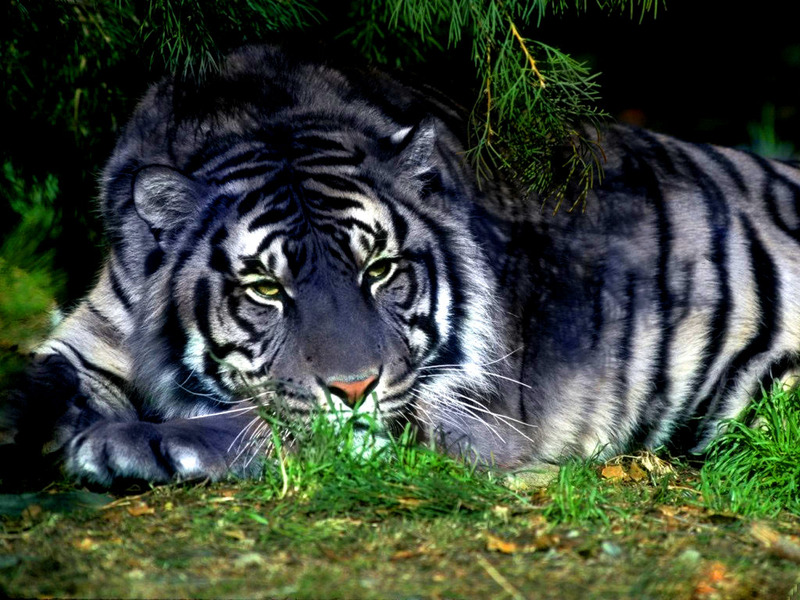Maltese Tiger - Wiki Maltese Tiger
From Wikipedia, the free encyclopedia
[Photo] Although there haven't been any verifiable claims to the existence of the Maltese tiger, this artist's rendition shows what one could look like.
The Maltese tiger, or blue tiger, is a suspected coloration morph of tiger, reported mostly from the Fujian Province of China. It is said to have bluish fur with dark grey stripes. The term Maltese comes from domestic cat terminology for blue fur, and refers to the slate grey coloration; the tigers have nothing to do with the island of Malta.
Most of the Maltese tigers reported have been of the South Chinese subspecies. The South Chinese tiger today is critically endangered, and the "blue tiger" gene may be wholly extinct. However, blue animals have also been reported from Korea, home of Amur tigers.
Sightings
Around 1910, Harry R Caldwell, an American missionary and big game hunter, spotted and hunted a blue tiger outside Fuzhou. His search is chronicled in his book Blue Tiger (1924), and by his hunting companion Roy Chapman Andrews in his Camps & Trails in China (1925, chapter VII). (This latter book is available on-line at Project Gutenberg.)
A more recent report, given to Mystery Cats of the World author Dr Karl Shuker, comes from the son of a US Army soldier who served in Korea during the Korean War. His father sighted a blue tiger in the mountains near what is now the Demilitarized Zone. Blue tigers have also been reported from Burma.
A smokey blue pseudo-melanistic tiger cub was born in the Oklahoma Zoo in 1964 to ordinary Bengal tiger parents. It died in infancy and is preserved as a bottled specimen. There are no blue tigers in zoos or private collections, and no known blue tiger pelts.
Genetics
In support of the blue tiger theory, Maltese-colored cats certainly do exist. The most common is a domestic breed, the Russian Blue, but blue bobcats and lynxes have also been recorded, and there are genetic mutations and combinations that result in blue tonings, or at least in the impression of a blue-gray animal. Indeed, the most plausible genetic explanation for the blue tiger is that it possesses two different pairs of recessive mutant alleles - the non-agouti, and the dilute - which in combination yield a distinctive blue-shaded pelage effect known as blue dilution. Less feasible is a variant expression of the chinchilla allele (the same allele found in white tigers).
The black tiger was also long considered mythical, but several pelts have proven that pseudo-melanistic tigers do exist. They are not wholly black, but have dense, wide stripes that partially obscure the orange background colour. A pseudo-melanistic tiger cub born in captivity at Oklahoma City Zoo had a smokey hue between some of the stripes.
Possible Distribution
In small or isolated populations, inbreeding can fix traits such as unusual coloration. A non-harmful mutation can soon become widespread in small, isolated and inbred populations. And if the mutant gene confers benefits, such as better camouflage, then affected individuals may out-compete those without the mutation.
Although less likely than the blue dilution hypothesis, it is possible that the blue tigers were due to a form of the chinchilla gene known as "shaded silver", familiar to domestic cat breeders. The South China tiger is considered the "stem species" from which all other tigers evolved, so it is conceivable that the chinchilla mutation occurred in the South China tiger and has been inherited by descendent species, resulting in blue and white varieties. It might have combined with other genes to produce white tigers in the Amur tiger (north eastern China, northern North Korea and Siberia) since the Amur and South China tigers' ranges may have historically overlapped, allowing interbreeding.
http://en.wikipedia.org/wiki/Maltese_Tiger
| The text in this page is based on the copyrighted Wikipedia article shown in above URL. It is used under the GNU Free Documentation License. You may redistribute it, verbatim or modified, providing that you comply with the terms of the GFDL. |
